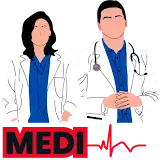Infectious mononucleosis is also known as mono glandular fever, Pfeiffer's disease, Filatov's disease, Kissing disease
It is also knowns as heterophile positive mononucleosis .it is a viral infection that is characterized by
- fever
- sore throat
- lymphadenopathy
- atypical lymphocytosis
In 1885, the renowned Russian pediatrician Nil Filatov reported an infectious process .he called Idiopathic adenitis. In 1889 a german balneologist and pediatrician Emil Pfeiffer independently said similar cases that tended to cluster in families for which he coined the term Glandular fever
The Epstein Barr virus was first identified in Burkitt's lymphoma cells by Michael Anthony Epstein and Yvonne Barr at the university of bristol in 1964
The virus was named mononucleosis because it is associated with an increase in specific white blood cells called lymphocytes in the bloodstream. the cause of Mononucleosis is the Epstein Barr virus.
it isn't a severe condition. Most adults have been exposed to the Epstein - Barr virus and have built up antibodies .they are immune and won't get mononucleosis again.
the majority of cases of infectious mononucleosis, more than 90 %are caused by the Epstein Barr virus which is in the herpes family
EBC also called human herpes virus 4 is one of the eight viruses in the human herpes virus family .it is one of the most common viruses in human
the sign and symptoms include
- Sore throat
- Malaise
- Headache
- Abdominal pain
- Nause and Vomiting
- chills
- Lymphadenopathy
- Fever
- pharyngitis or tonsillitis
- splenomegaly
- hepatomegaly
- Rash
- Periorbital edema
- palatal enanthem
- jaundice
Pathogenesis
After exposure in the oral cavity, EBV infects B lymphocytes. Morphologically abnormal (atypical) lymphocytes develop, mainly from CD8+ T cells that respond to the infection. After primary infection, EBV remains within the host, primarily in B lymphocytes, for life and undergoes intermittent asymptomatic shedding from the oropharynx.
The virus is detectable in oropharyngeal secretions of 15 to 25% of healthy EBV-seropositive adults. Shedding increases in frequency and titer in immunocompromised patients (eg, organ allograft recipients, HIV-infected people).EBV has not been recovered from environmental sources and is not very contagious.
Incubation Period
The virus has an incubation period of approximately four to six weeks, although in young children this period may be shorter. Signs and symptoms such as fever and sore throat usually lessen within a couple of weeks, although fatigue, enlarged lymph nodes, and a swollen spleen may last for a few weeks longer.
Transmission
Droplet infection
The virus that causes mono is transmitted through saliva, so you can get it through kissing, but you can also be exposed through a cough or sneeze, or by sharing a glass or food utensils with Someone who has mono.However, mononucleosis isn't as contagious as some infections, such as the common cold.
Complications
- Splenic rupture,
- Upper airway obstruction (because of Hypertrophy of lymphoid tissue) Bacterial superinfection
- CNS complications (meningitis, encephalitis)
- Autoimmune hemolytic anemia
- thrombocytopenia
- Fulminant hepatitis
- myocarditis or pericarditis pneumonia with pleural effusion, Complications
- Jaundice
Investigations
- LFT,
- USG
- EBV-specific antibody testing
- CBC (to look for an elevated number of white blood cells
- lymphocytes) or abnormal-looking lymphocytes
- Serologic testing
Tests for heterophile antibodies are positive in 40% of patients with IM during the first week of illness and in 80-90% during the third week
Treatment.
There's no specific therapy available to treat infectious mononucleosis. Antibiotics don't work against viral infections such as mono.
Treatment mainly involves bed rest and drinking plenty of fluids.
- Anti- Histamine
- Therapy for IM consists of supportive measures, with rest and analgesia
- Corticosteroids
- Antipyretics
•Treating secondary infections.
See more>>>
NOTES


